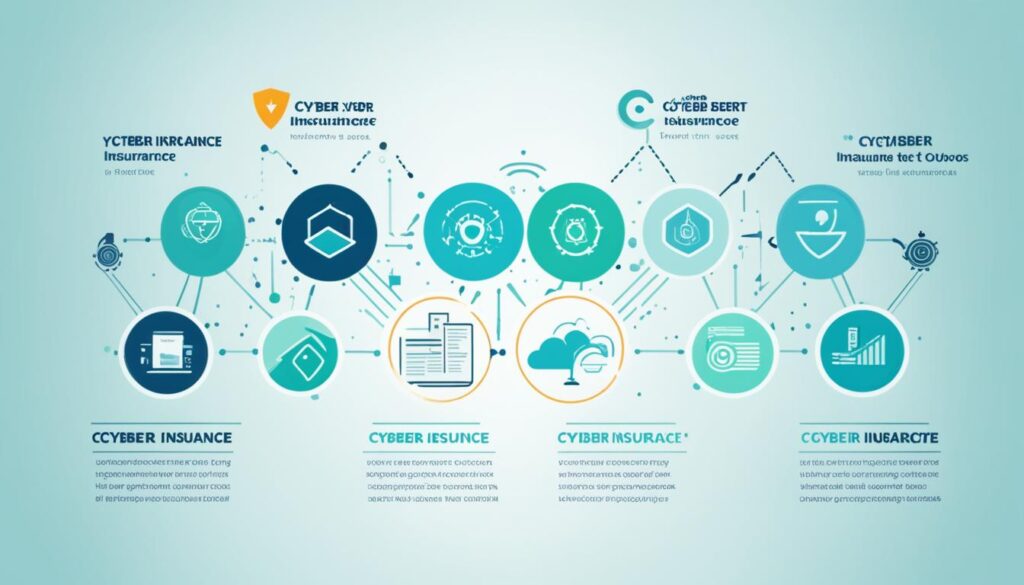In today’s hyperconnected world, a staggering 43% of businesses have lacked proper data breach coverage in the face of a cyber-attack—illustrating a considerable gap in cyber risk management strategies. This stark reality underscores the importance of cyber insurance as a critical component of your comprehensive defense plan against digital threats.
As the digital landscape evolves, the cyber insurance market responds, swelling in demand for policies that offer not just recovery support, but proactive measures against the vast array of cyber perils. In-depth cyber insurance market analysis shows that awareness is growing, with an ever-increasing number of organizations recognizing the indispensable role cyber insurance plays in their overall risk management framework.
Are you prepared to navigate this intricate web of digital risks? Understanding the latest cyber insurance trends could mean the difference between falling victim to the next headline-making data breach and confidently steering your enterprise through the ever-changing storm of cyber threats.
Key Takeaways
- The growing necessity for data breach coverage in an era where cyber threats loom larger than ever.
- Insight into why robust cyber insurance is a non-negotiable aspect of modern cyber risk management.
- An overview of the importance of cyber insurance for businesses seeking fortification against digital adversaries.
- Current cyber insurance market analysis, highlighting the expansion of the industry and its alignment with evolving cyber risks.
- Forward-looking discussion about the broadening scope and complexity of cyber insurance products available to consumers.
Exploring the Evolving Cyber Insurance Market
As cyber threats become more sophisticated, the insurance market is rapidly adapting to mitigate risks faced by businesses worldwide. Innovations in insurance industry technology spearhead the development of tailored cyber insurance policies, shifting the landscape to focus on specialized, comprehensive coverage against cyber attacks. Let’s delve into how this sector is tailoring its offerings to meet the demands of a digitally connected economy.
The Expansion of Cyber Insurance Offerings
The traditional boundaries of insurance have stretched to encompass the digital realm, giving birth to cyber liability insurance. Insurers are now offering policies that not only protect against data breaches but also cover regulatory fines, crisis management, and even reputational damage. This nuanced approach allows businesses to feel safer in a digital climate that’s prone to rapid change and uncertain risks.
Statistics Reflecting Cyber Insurance Market Growth
The numbers are speaking, and they are loud and clear: the demand for insurance coverage for cyber attacks is on an unprecedented rise. Industry reports demonstrate a consistent upward trend in businesses investing in cyber insurance policies, highlighting the growing consciousness of cyber risks and their financial implications.
Let’s look at the telling statistics that encapsulate the cyber insurance industry trends:
| Year | Policy Uptake (% Increase) | Claim Frequency (% Increase) |
|---|---|---|
| 2020 | 25 | 30 |
| 2021 | 40 | 50 |
| 2022 | 60 | 70 |
Insurance Industry’s Response to Cyber Threats
Confronting the tide of cyber threats requires a robust defense strategy. The insurance sector has taken a proactive stance, incorporating advanced predictive models and cyber risk assessments to not just respond to incidents but to prevent them. With the uptake of cutting-edge technology, insurers are empowered to offer more accurate, preventative measures, ensuring clients receive the most relevant and supportive cyber insurance industry trends.
The forward movement of this market is a testament to the commitment of safeguarding businesses in the digital age. As you navigate through the options, keep in mind the evolution and customized nature of cyber insurance offerings that now stand as critical shields in protecting your business’s assets and reputation.
Cyber Insurance Trends in Addressing Emerging Threats

As cyber threats continue to arise with increasing complexity and frequency, the landscape of cyber liability trends is evolving at a rapid pace. It’s crucial for businesses to stay abreast of emerging cyber threats, and the insurance industry trends play a pivotal role in shaping responsive and robust cyber insurance solutions. This strategic alignment is instrumental in safeguarding businesses against financial repercussions of cyber incidents.
Mastering Digital Safety: Essential Cybersecurity Hygiene Practices for the Digital Age
The development of comprehensive insurance solutions that are responsive to these evolving cyber insurance trends is key in mitigating risk. The following insights reveal why it’s imperative for you and your business to understand and integrate these innovations into your cybersecurity strategy:
- Emerging threats such as ransomware, phishing, and state-sponsored attacks require tailored insurance solutions that go beyond traditional policies.
- The integration of cybersecurity expertise and insurance underwriting is producing more effective risk assessments and policy frameworks.
- An increase in cyber insurance uptake is signaling heightened awareness amongst businesses concerning the potential impact of digital threats.
- Insurance carriers are partnering with tech companies to provide preemptive security measures as a value-add to their insurance products.
Understanding these trends is not merely about protection; it’s an investment in the resilience of your business against the dynamic backdrop of cyber threats.
The synergy between the advanced risk modeling techniques and new insurance products is yielding promising results in the insurance landscape. As cyber threats evolve, so too does the nature of managing and insuring against them. It’s a cycle of continuous improvement that ensures evolving cyber insurance trends will remain a cornerstone in the ongoing quest to combat digital risks.
Assessing Cyber Risk: Tools and Techniques
In today’s digital era, where technology security is paramount, businesses are increasingly turning to robust cyber risk assessments to protect their operations from malevolent cyber activities. Understanding the landscape of threats and the importance of cyber risk mitigation is the first step in fortifying your company’s defenses against potential cyber-attacks.
Modern Cyber Risk Assessment Services
As you seek to navigate the complex realm of cybersecurity, modern risk assessment services come into play. These services include comprehensive evaluations of your technology infrastructure, identifying vulnerabilities and providing actionable insights into how to reinforce your security posture.

Integrating Technology and Expertise in Risk Management
The synergy between cutting-edge technology and seasoned expertise lies at the heart of effective cyber risk management. By integrating the latest security tools with the knowledge of experienced professionals, your business can develop a formidable barrier against cyber risk trends that threaten corporate integrity.
The Role of AI in Predicting Cyber Risk Trends
Artificial Intelligence (AI) is revolutionizing the way businesses predict and respond to emerging cyber threats. By leveraging AI-powered analytics, companies can anticipate cyber risk trends, making proactive adjustments to their security strategies before threats materialize.
| Assessment Category | Services Offered | Benefits |
|---|---|---|
| Vulnerability Scanning | Automated analysis of systems to detect vulnerabilities | Identifies and prioritizes security weaknesses |
| Penetration Testing | Simulated cyber-attacks to evaluate defenses | Reveals real-world security exposure |
| Threat Modeling | Identification of potential threats and assessment of impacts | Provides a structured approach to threat detection |
| Risk Analysis | Quantitative and qualitative assessment of cyber risk exposure | Guides strategic decision-making in risk mitigation |
| Compliance Audits | Checks systems against industry standards and regulations | Ensures adherence to legal requirements and best practices |
By integrating these sophisticated assessments and AI enhancements, your business can stay one step ahead in its cyber risk mitigation efforts. Whether it’s through preempting threats or swiftly responding to incidents, embracing these tools and techniques is critical for maintaining resilient technology security.
The Importance of Cyber Insurance for Businesses
As the digital world becomes increasingly interconnected, the need for robust data breach protection and other forms of cyber security measures cannot be overemphasized. In the realm of safeguarding assets and maintaining operational integrity, cyber insurance trends are on the rise, shaping up to be a linchpin in the corporate risk management strategies of today and tomorrow.
From Startups to Corporations: Who Needs Cyber Insurance?
Whether you are running a sprightly startup or managing a vast corporate empire, the threat of cyberattacks is universal. This staggering reality makes cyber insurance a critical shield for businesses across the spectrum. Emerging trends in cyber insurance indicate that a diverse range of industries, recognizing the gravity of cyber threats, are now pursuing custom-tailored insurance solutions—reflecting a proactive stance on risk management.
Case Studies: Cyber Insurance Mitigating Financial Loss
Real-world case studies underscore the efficacy of cyber insurance in mitigating financial ruin post-data breaches. For instance, one notable case involved an e-commerce company that suffered a massive data breach, potentially exposing millions of customers’ personal information. Thanks to their comprehensive cyber insurance policy, they could cover the costs of customer notification, credit monitoring services, and legal defense, shielding them from devastating financial implications.
Customized Policies for Diverse Industry Needs
The versatility of the cyber insurance market growth is evident in the wide array of custom policies designed to address the unique risks faced by different industry sectors. These adaptable cyber insurance solutions support businesses in fortifying their defenses against a broad spectrum of cyber threats, making it a vital component of an organization’s defense strategy against digital dangers.

Understanding the nuances of these offerings is key for companies looking to leverage cyber insurance trends for maximum protection. With the landscape of digital threats constantly evolving, your business’s survival could very well depend on the cyber insurance choices you make today.
Understanding Cyber Insurance Policy Features
As cyber threats continue to evolve, staying informed on cyber insurance policy features is crucial for safeguarding your business. With the dynamic nature of the digital realm, key cyber insurance trends are reshaping the protections available. Let’s delve into the aspects of cyber insurance coverage you should be aware of, complemented by the most recent insurance policy updates.
Start earning effortlessly! Claim your $3 bonus and monetize your unused data with Honeygain. It’s simple, secure, and smart.
Claim Nowand watch your balance grow! 🍯💸

Today’s cyber insurance policies encompass a wide array of features designed to address the multifaceted nature of cyber risks. Below, uncover the core components of cyber insurance that contribute to a robust defense against online threats:
- Incident Response Support: Access to a dedicated team specializing in cyberattack response and mitigation.
- Legal Fees Coverage: Financial protection against legal costs that may arise from cyber incidents.
- Data Recovery Services: Guidance and assistance in retrieving lost or corrupted data.
- Forensics Analysis: Expert investigation to determine the cause and extent of a breach.
- Business Interruption Losses: Compensation for income lost due to disruptions caused by cyber events.
- Cyber Extortion Defense: Protection in scenarios involving ransomware or cyber extortion demands.
- Notification Costs: Coverage for expenses related to informing affected parties of a security breach.
With the landscape of digital threats ever-changing, insurers are continually updating policies. Recent trends suggest an increased focus on:
Emerging threats such as IoT vulnerabilities and artificial intelligence-powered attacks, requiring specialized risk assessments and custom coverage options.
Moreover, policy enhancements now extend to support for regulatory compliance and penalties, considering global data protection laws like GDPR. To stay ahead, routinely review your cyber insurance coverage and align it with the latest industry developments.
Remember, cyber insurance policy features are more than a safety net—they’re a strategic component of your business continuity plan. Stay vigilant and informed. Tailoring your cyber insurance coverage to reflect both your business model and the current climate of online threats ensures that when your security is tested, you’re prepared not just to react, but to recover and thrive.
How Cyber Risks Are Reshaping the Insurance Claims Process
The ever-changing digital landscape has ushered in a new era of risk management essentials, with the insurance claims process feeling the ripple effects of the evolving cyber insurance market. Businesses like yours are increasingly reliant on technological advancements to manage and safeguard against digital threats. Let’s dive into how Insurtech innovations are not only transforming claims handling but also spawning new insurance coverage trends.

Streamlining Claims with Insurtech Innovations
The integration of Insurtech innovations into the insurance industry has been a game-changer, directly impacting how cyber insurance claims are processed. User-friendly platforms and automation tools offer a streamlined, efficient approach to handling what was once a cumbersome process. This not only accelerates claim resolutions but also enhances customer satisfaction, which is paramount in the competitive insurance coverage trends you’re witnessing today.
Training for Insurance Agents in the Digital Age
The technology skill gap has become more pronounced as the industry evolves, which is why investing in continuous training for insurance agents is critical. Your insurance agents now need to be adept with cybersecurity concepts and the intricacies of digital insurance products. This will ensure they are well-equipped to address client concerns and manage the nuances of the evolving cyber insurance market.
Challenges in Assessing Cyber-Related Claims
Despite technological advances, the nature of cybersecurity means that assessing cyber-related claims remains complex. The anonymized and borderless realm of cyber threats often presents unique challenges in identifying, quantifying, and validating claims—a stark contrast to traditional insurance models. Your ability to navigate this terrain will be determinant in maintaining resilience in the face of cyber adversities.
Regulatory Trends Impacting Cyber Insurance Policies
As you navigate the complexities of the insurance market dynamics, it’s crucial to understand how cybersecurity regulations influence the evolution of cybercrime insurance. Diverse regulatory frameworks across the globe establish standards that ensure businesses maintain a robust posture against escalating cyber threats, ultimately shaping the contours of the global cyber insurance trends.

Global Cybersecurity Regulations and Compliance
Echoing through the fabric of international commerce are the stringencies of global cybersecurity regulations. Compliance is no longer optional; it is a requisite for safeguarding digital assets and consumer data. From GDPR in the European Union to evolving frameworks in Asia, and the OECD’s guidelines, these legal structures form a safety net across continents, compelling businesses to fortify their cyber defense mechanisms—necessitating the growth of cybercrime insurance solutions.
State-Level Cyber Insurance Mandates in the U.S.
Within the United States, state-level mandates are emerging as pivotal forces in driving the adoption of cyber insurance policies. Take, for instance, the New York Department of Financial Services’ Cybersecurity Regulation (23 NYCRR 500), mandating cyber risk management practices for financial services companies. Such localized legal prescripts cast varying shadows on the insurance market dynamics, demanding that policies remain nimble and tailored to comply with a patchwork of regulatory demands.
Insurance Industry’s Lobbying on Cybersecurity Legislation
Insurers are not bystanders in the arena of cybersecurity regulation. They wield influence, engaging in lobbying efforts to shape cybersecurity legislation that aligns with pragmatic risk management while fueling sustainable growth in cyber insurance products. The delicate interplay between regulatory bodies and the insurance market ensures cyber insurance trends resonate with the evolving landscape of digital risk.
| Regulation | Region | Impact on Cyber Insurance |
|---|---|---|
| General Data Protection Regulation (GDPR) | European Union | Increased demand for policies covering data breach penalties and response costs |
| California Consumer Privacy Act (CCPA) | California, U.S. | Stricter consumer data protection standards pushing for tailored cyber liability coverage |
| Cybersecurity Regulation (23 NYCRR 500) | New York, U.S. | Compulsory cyber risk management promoting adoption of comprehensive insurance policies |
Future of Cyber Insurance: Predictions and Preparations
As digital threats continue to evolve, keeping an eye on the future cyber insurance trends is more than just foresight; it’s a necessity for your business’s resilience. Experts within the industry are making some bold predictions in cyber insurance that could fundamentally change the way businesses approach their digital security strategies. From the rise of policies tailored to artificial intelligence and machine learning to real-time, data-driven coverage adjustments, the cyber insurance domain is expected to undergo significant transformations.
Your readiness in preparing for digital security trends will hinge upon adaptability and proactive measures. In anticipation of these changes, it’s essential to understand the risks specific to your industry and invest in cybersecurity infrastructure that’s both nimble and robust. By staying informed about the significant cyber insurance trends, as well as legislative developments, you’ll be better equipped to protect your assets and maintain compliance in an ever-shifting landscape.
To navigate these upcoming shifts in the market, it’s crucial to work closely with insurance providers who are at the forefront of these trends, using their insights to inform your cyber risk management plan. Brace yourself for a future where cyber insurance is not only about mitigating losses post-incident but about being one step ahead in an online world that never sleeps. By being prepared, you’ll ensure that your organization remains steadfast and secure, no matter what the digital future holds.
Transforming Cybersecurity: The Impact of AI and Machine Learning Technologies

